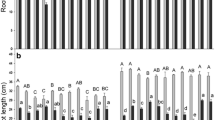Abstract
Accumulation of potassium ions (K+) in expanding or most recently expanded leaves and exclusion of sodium ions (Na+) from them (K+/Na+ selectivity) have been shown to be associated with salt stress tolerance in wheat and Lophopyrum elongatum, a highly salt stress tolerant relative of wheat. This physiological trait is expressed in an amphiploid from the cross of wheat (cv. Chinese Spring) × L. elongatum and the chromosomes controlling it have been identified in field studies employing Chinese Spring disomic substitution lines with individual L. elongatum chromosomes. In this paper the arm location of these genes was investigated by assessing K+/Na+ selectivity in lines harboring individual chromosomes and chromosome arms of L. elongatum. Lophopyrum elongatum chromosome arms 1ES, 7ES, and 7EL, were shown to enhance K+/Na+ selectivity in wheat.
Similar content being viewed by others
References
Colmer, T.D., E. Epstein & J. Dvorak, 1995. Differential solute regulation in leaf blades of various ages in salt-sensitive wheat and a salt-tolerant wheat × Lophopyrum elongatum (Host) Love, A. amphiploid. Plant Physiology 108: 1715–1724.
Dvorak, J., 1979. Metaphase I pairing frequencies of individual Agropyron elongatum chromosome arms with Triticum chromosomes. Canadian Journal of Genetics and Cytology 21: 243–254.
Dvorak, J., 1980. Homoeology between Agropyron elongatum chromosomes and Triticum aestivum chromosomes. Canadian Journal of Genetics and Cytology 22: 237–259.
Dvorak, J. & K.C. Chen, 1984. Phylogenetic relationships between chromosomes of wheat and chromosome 2E of Elytrigia elongata. Canadian Journal of Genetics and Cytology 26: 128–132.
Dvorak, J., M. Edge & K. Ross, 1988. On the evolution of the adaptation of Lophopyrum elongatum to growth in saline environments. Proceedings of the National Academy of Sciences U.S.A. 85: 3805–3809.
Dvorak, J. & J. Gorham, 1992. Methodology of gene transfer by homoeologous recombination into Triticum turgidum: Transfer of K+/Na+ discrimination from T. aestivum. Genome 35: 639–646.
Dvorak, J. & K. Ross, 1986. Expression of tolerance of Na+, K+, Mg2+, Cl-, and SO4 2− ions and seawater in the amphiploid of Triticum aestivum × Elytrigia elongata. Crop Science 26: 658–660.
Forster, B.P., T.E. Miller & C.N. Law, 1988. Salt tolerance of two wheat-Agropyron junceum disomic addition lines. Genome 30: 559–564.
Galvez, A.F., P.J. Gulick & J. Dvorak, 1993. Characterization of the early stages of genetic salt stress responses in salt-tolerant L. elongatum, salt-sensitive wheat, and their amphiploid. Plant Physiology 103: 257–265.
Gorham, J., E. McDonnell, E. Budrewiezs & R.G. Wyn Jones, 1985a. Salt tolerance in the Triticeae: Growth and solute accumulation in leaves of Thinopyrum bessarabicum. Journal of Experimental Botany 36: 1021–1031.
Gorham, J., R.G. Wyn Jones & E. McDonnell, 1985b. Some mechanisms of salt tolerance in crop plants. Plant and Soil 89: 15–40.
Omielan, J., E. Epstein & J. Dvorak, 1991. Salt tolerance and ionic relations of wheat as affected by individual chromosomes of salt-tolerant Lophopyrum elongatum. Genome 34: 961–974.
Palta, J.P., 1996. Role of Calcium in Plant Responses to Stresses — Linking Basic Research to the Solution of Practical Problems. Hortscience 31: 51–57.
Rafi, M.M., E. Epstein & R.H. Falk, 1997. Sillicon deprivation causes physical abnormalities in wheat (Triticum aestivum L.). Journal of Plant Physiology 151: 497–501.
Schachtman, D.P., A.J. Bloom & J. Dvorak, 1989. Salt-tolerant Triticum — Lophopyrum derivatives exclude sodium and chloride ions. Plant Cell and Environment 12: 47–55.
Schachtman, D.P. & R. Munns, 1992. Sodium accumulation in leaves of Triticum species that differ in salt tolerance. Australian Journal of Plant Physiology 19: 331–340.
Storey, R., R.D. Graham & K.W. Shepherd, 1985. Modification of the salinity response of wheat by the genome of Elytrigia elongatum. Plant and Soil 83: 327–330.
Tuleen, N.A. & G.E. Hart, 1988. Isolation and characterization of wheat — Elytrigia elongata chromosome 3E and 5E addition and substitution lines. Genome 30: 519–524.
Zhong, G.Y. & J. Dvorak, 1995a. Chromosomal control of the tolerance of gradually and suddenly imposed salt stress in Lophopyrum elongatum and wheat, Triticum aestivum L., genomes. Theoretical and Applied Genetics 90: 229–236.
Zhong, G.Y. & J. Dvorak, 1995b. Evidence for common genetic mechanisms controlling the tolerance of sudden salt stress in the tribe Triticeae. Plant Breeding 114: 297–302.
Author information
Authors and Affiliations
Rights and permissions
About this article
Cite this article
Deal, K., Goyal, S. & Dvorak, J. Arm location of Lophopyrum elongatum genes affecting K+/Na+ selectivity under salt stress. Euphytica 108, 193–198 (1999). https://doi.org/10.1023/A:1003685032674
Issue Date:
DOI: https://doi.org/10.1023/A:1003685032674




